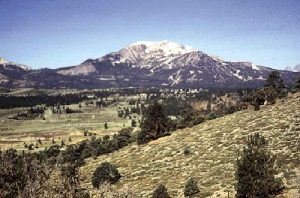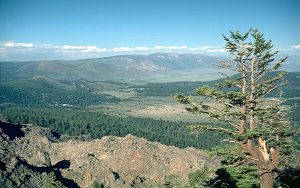 During the gold rush years, in 1857, to be exact, two German men who had been traveling with a wagon train headed to California, decided to leave the rest of the group and headed out on their own. They wound up in the Mono Lake region of northern California. One of the men would later describe the area as “the burnt country.” While crossing the Sierra Nevada near the headwaters of the Owens River, they sat down to rest near a stream. Looking around, they noticed a curious looking rock ledge of red lava filled with what appeared to be pure lumps of gold “cemented” together. That was how their “mine” got its name.
During the gold rush years, in 1857, to be exact, two German men who had been traveling with a wagon train headed to California, decided to leave the rest of the group and headed out on their own. They wound up in the Mono Lake region of northern California. One of the men would later describe the area as “the burnt country.” While crossing the Sierra Nevada near the headwaters of the Owens River, they sat down to rest near a stream. Looking around, they noticed a curious looking rock ledge of red lava filled with what appeared to be pure lumps of gold “cemented” together. That was how their “mine” got its name.
The ledge of that hillside was literally loaded with the ore. The excited men couldn’t believe their eyes. One of the men was laughing at the other as he pounded away about ten pounds of the ore to take with him…because he did not believe it was really gold. The man who believe that it was gold drew a map to the location and the two men continued their journey. Along the way, the disbeliever died and since he was laden with so much ore, the believer tossed the majority of the samples. Then, after crossing the mountains, he followed the San Joaquin River to the mining camp of Millerton, California. After a long, weary journey, the German had become ill and soon went to San Francisco for treatment. He was diagnosed and cared for by a Doctor Randall who told the man he was terminally ill with consumption (tuberculosis). With no money to pay the doctor and too ill to return to the treasure, he paid his caretaker with the ore, the map he had drawn, and provided him with a detailed description.
Doctor Randall shared this knowledge with a few of his friends and together they decided to go for the gold. They arrived at old Monoville in the spring of 1861. After enlisting additional men to help, Randall’s group began to prospect on a quarter-section of land called Pumice Flat. Their claim is thought to have been some eight miles north of Mammoth Canyon…the 120 acres were near what became known as Whiteman’s Camp. Word of possibly a huge cache of gold spread quickly and before long miners flooded the area hunting for the gold laden red “cement.” One story tells that two of Doctor Randall’s party had in fact found the “Cement Mine,” taking several thousand dollars from the ledge. Unfortunately, for those two men, the area was filled with the Owens Valley Indian War which began in 1861. The Paiute Indians, who had heretofore been generally peaceful, were angered at the large numbers of prospectors who had invaded their lands. The two miners who  had allegedly found the lost ledge were killed by the Indians before they were able to tell of its location.
had allegedly found the lost ledge were killed by the Indians before they were able to tell of its location.
Though the “cement” outcropping was never found again, the many prospectors who flooded the eastern Sierra region did find gold. Apparently there was a huge cache there after all. This resulted in the mining camps of Dogtown, Mammoth City, Lundy Canyon, Bodie, and many others. The lost lode is said to lie somewhere in the dense woods near the Sierra Mountain headwaters of the San Joaquin River’s middle fork. If it really exists, it must be very well hidden.


Leave a Reply